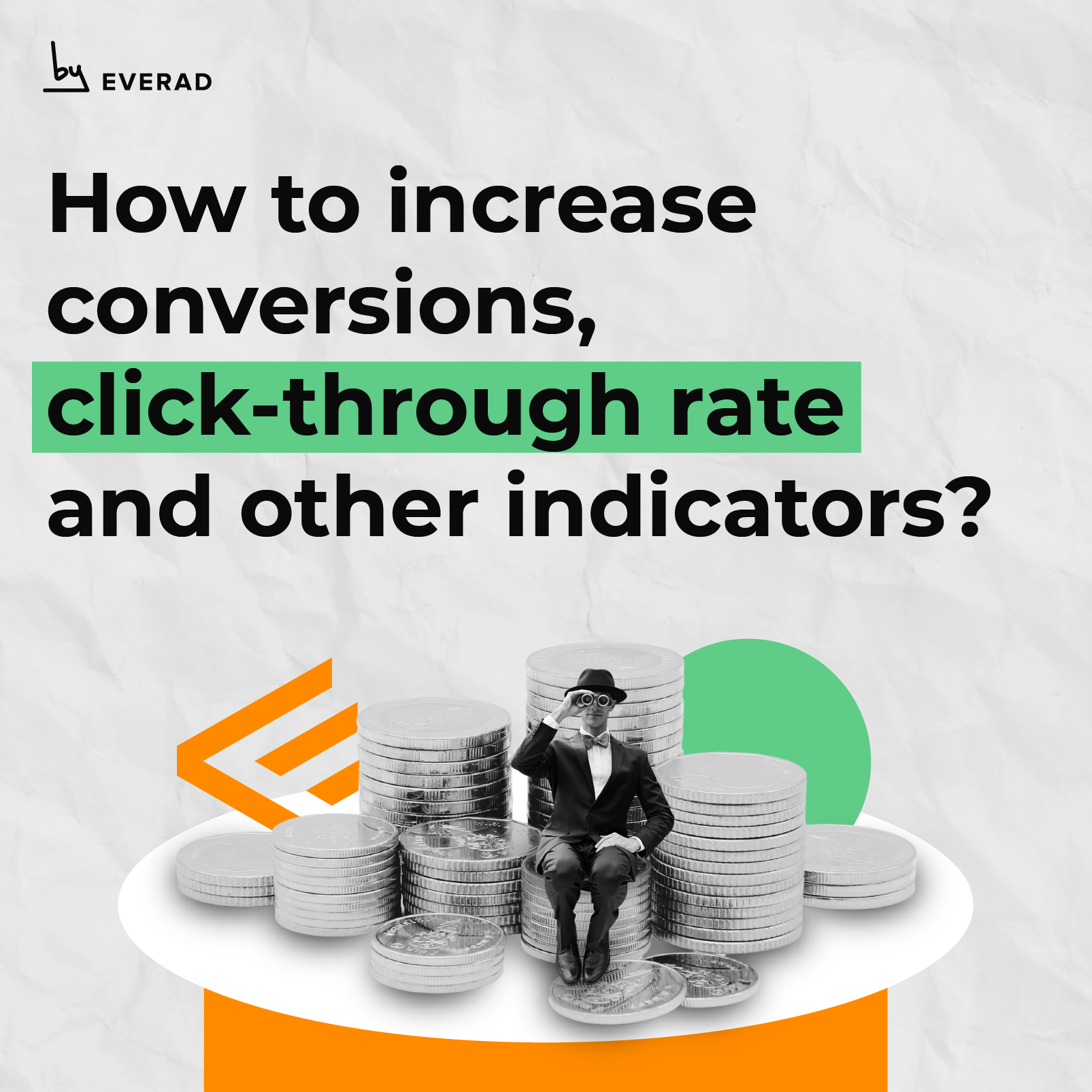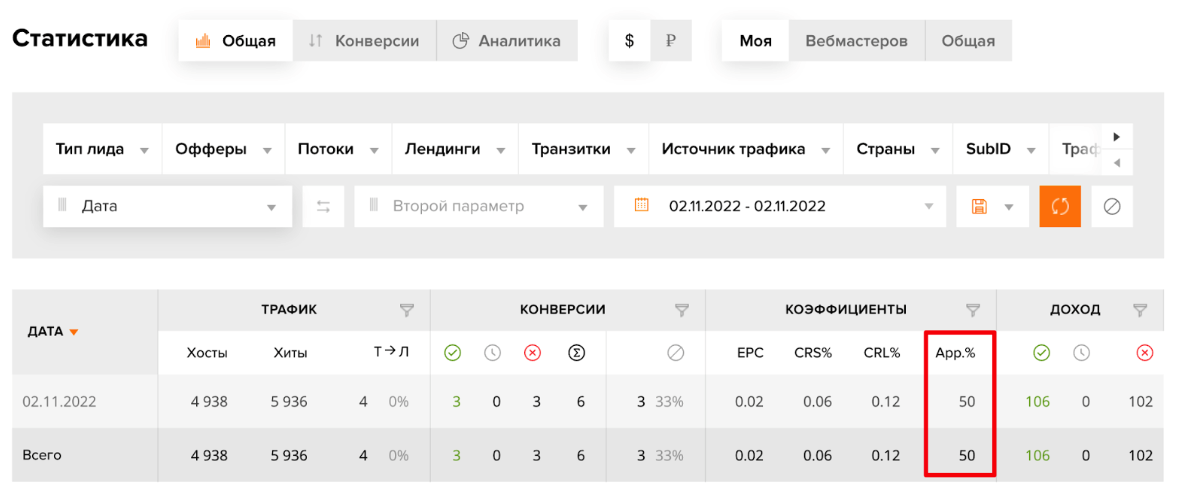
How to increase conversions, click-through rate and other indicators?
When campaigns are launched, one of the most critical stages of work begins – optimizing and improving fannels. The affiliate collects user reaction data, highlights campaign problem areas, and seeks to fix them to get more customers.
In this article, we have highlighted the most common fannels parameters:
- Conversions (CR)
- Click-through rate (CTR)
- Approve
- ROI
We told how to track specific indicators, how they can be improved, and what to look for when working with them. You will also learn what fluctuations of specific parameters depend on and why they can fall.
Let’s start!
Conversions (CR)
The conversion rate (CR) indicates the number of site visitors to those who completed the target action. It is measured as a percentage – for example, if CR=30%, then 30% of all website visitors have achieved the target action.
Connect metrics to your site, such as Google Analytics, to track CR. They will collect visitor data and calculate the conversion rate themselves.

An alternative option is to calculate it yourself, according to the formula:
The number of conversions\number of visitors * 100%.
The conversion rate depends on the content of the landing page because it is the landing page that leads the viewer to the target action.
Reasons why CR may drop and ways to fix it:
- Long loading time. If your site takes a long time to load, some users will leave the page without waiting for it to load. Check the Internet speed in the region, optimize the site, remove unnecessary graphics, and evaluate the download speed using Google PageSpeed Insights;
- Funnel length. Sometimes, longer or shorter landing pages can turn off the audience. Study cases and experiments with length will help you find effective options.
The information content is vital to one audience, and simplicity and ease of shopping are essential to another;
- Languages. Check the quality of translations – it is better to use the services of a native speaker in the desired region. A poor-quality translation undermines trust and forces one to abandon the targeted action;
- Perception. Make sure your landing pages are easy to read – mark up the text, dilute the content with images and videos, and take care of a light modern design and navigation.
The easier it is to perceive information from a landing page, the higher the chances of conversion;
- Social proof. Be sure to include images of doctors, testimonials, certificates, and other content to inspire confidence in the page. Back up words with numbers, and don’t forget about user reactions – they often influence the purchase decision;
- Form. Check if the order form works correctly and is convenient enough. For example, animations will only exacerbate the experience in regions with poor internet, as they need to be downloaded;
- Call to action. Remember to leave calls to action and links to the landing page on re-landers. Often, in pursuit of colorful stories and information content, you can forget that the viewer needs to be motivated to buy.
Click-through rate (CTR)
CTR is a metric that measures the percentage of users who click on an ad. It is also calculated as a percentage – if the CTR is 5%, then 5% of those who saw it clicked on the ad.
As a rule, click-through rate can be tracked in any advertising account – advertising networks collect and display these statistics.

Also, you can calculate by the formula:
A number of clicks\number of views * 100%.
Click-through rate depends on creatives, targeting settings, algorithms’ effectiveness, and the traffic source’s specifics.
Reasons why CTR can be low and ways to increase it:
- Outdated creos. Find ideas for creatives using SPY services, study the experience of other webmasters, and consult with your manager – this will help you find relevant ideas.
Don’t forget to update your creatives and track their effectiveness – from time to time, promotional materials lose their relevance, and the audience gets used to them;
- Targeting mistakes. Make sure you select the correct audience segments in the correct regions. A small error in targeting – and the chances of success tend to zero.
Also, check if you have disabled inefficient regions with low solvency. For example, in Italy – the region of Palermo;
- Need more time for optimization. Refrain from jumping to conclusions, mainly if you use auto-optimization algorithms. Sometimes they need up to two weeks to find an audience;
- The specifics of the traffic source. You should make reasonable demands on the clickability of specific sources. For example, banner ads or push notifications will never bring such clickability as social networks and search engines;
- Irrelevant creatives. Check that the offer on the creative matches the content of the landing page and the viewer’s requirements.For example, if the text on the banner is too small, people with visual impairments cannot read it. It is worth considering such minor details, especially if you are promoting offers for an older audience 😉
- Languages. As in the case of conversions, the problem may be in poor-quality translation of creatives;
- Show time. Analyze click-through statistics at different hours – you can show ads at peak times and not spend your budget on inefficient periods.
Approve
Approve is an indicator of how many leads eventually became customers. Measured as a percentage, it shows how many people out of the total agreed to the deal. If approve is 50%, half of the leads paid for the offer.
The difference between CR and approve is that CR reflects only the direct target action, for example, filling out and submitting a form on a landing page. Approve helps to determine how many customers, after the target action, still reached the purchase, successfully paid, and received the goods.
Approve is calculated by the affiliate network – as a rule, you can see its indicator in the flow statistics. For example, at Everad we share approve data here:

The formula for calculating the approve:
Number of approved leads/total number of leads * 100%
Approve depends on the quality of the traffic, the credibility of the content in promotional materials, the behavior of the call center operator, and local circumstances.
Why can the approval fall and how to raise it:
- Traffic quality. Poor-quality traffic leads to failures, insolvency, ignoring the operator and getting the lead into the trash. If the approval suffers for no apparent reason, the traffic is almost always the problem.
To fix this, try bidding up on the Ad Auction or changing the source;
- High expectations. Often, landing pages and creatives create inflated expectations among viewers. During communication with the operator, a person will discover the details and refuse the transaction.
To prevent this from happening, make sure that promotional materials create a realistic idea of the offer and conditions;
- Ignoring the requirements of the advertiser. A low approval may be because the webmaster needs to pay more attention to the advertiser’s requirements, such as using prohibited sources or geos.

Make sure you follow the rules – otherwise, you can get blocked in the affiliate network;
- Call center attitude. If call center operators impose additional sales, react slowly to requests, and need help understanding the specifics, this will negatively affect the approval.
To prevent this from happening, you should check the reviews about the affiliate network and its call center in advance or make a test request and try to communicate with the operator yourself;
- Affiliate network policy. To ensure high payouts, some affiliate networks carefully filter traffic and weed out even those leads that could make a profit.
To avoid falling into such a trap, check the statistics of the offer. Too low approval with high payouts will tell you that the affiliate network is probably lowering the support on purpose;
- Local circumstances. Follow the regional agenda in the region – delivery problems, armed conflicts, or quarantines will also negatively affect the approval.
ROI
ROI (Return on Investment) is the primary indicator of the profitability of the affiliate marketer. It reflects how much of the money spent the webmaster returned and how much profit he received. It is measured as a percentage – the ROI is 30%; the webmaster returned the investment and earned + 30% of the investment.
ROI can be calculated in many ways – it can be calculated by trackers and analytics tools, unique spreadsheets in Excel, or even by the webmaster himself if he keeps track of income and expenses.
You can calculate ROI using the formula:
((Income – Costs) / Costs) x 100%
ROI depends on various metrics, including conversions, click-through rates, and approval. Below we have collected tips that do not depend on these indicators – as we have already told you how to raise them.
So, here’s why ROI can be low and what to do about it:
- Low payouts. You should ask for a bump or pick up another offer.
- Improper money management. Ensure you control your costs – check how much you spend on tools, supplies, training, and support.
Beginners often spend their budget in vain, so it’s worth writing down expenses and spending only on what is necessary. Creo can be developed without paid editors, and it will not be possible to track the creatives of competitors without a SPY service;
- Too expensive traffic. Perhaps you have set too high a bid for traffic, or you have chosen an overpriced source for the offer;
- There are no additional monetization channels. If ROI suffers, you can connect additional monetization; we have already talked about it;
- Low volumes. To pay off and earn money, you need to be able to purchase traffic in sufficient volumes. Make sure you have enough working capital;
- Wrong calculations. Calculate the marginal price of the lead so as not to go into the red.
Formula: “Offer payout*approve = maximum lead cost.”
Results
- You can track the effectiveness of the link, collect data and adjust it according to various parameters – such as CR, CTR, Approve and ROI;
- CR – conversion rate, calculated according to the formula “Number of conversions \ number of visitors * 100%”;
- CTR – click-through rate, calculated according to the formula “Number of clicks \ number of views * 100%”;
- Approve – an indicator of the redemption of an offer by a lead, calculated according to the formula “Number of approved leads\total number of leads * 100%.”
- ROI – return on investment, calculated according to the formula “((Income – Costs) / Costs) x 100%”;
- Any failure is the result of our mistakes. If you track and correct them in time, you can earn more and increase your chances of success.

 Українська
Українська Русский
Русский
Reviews